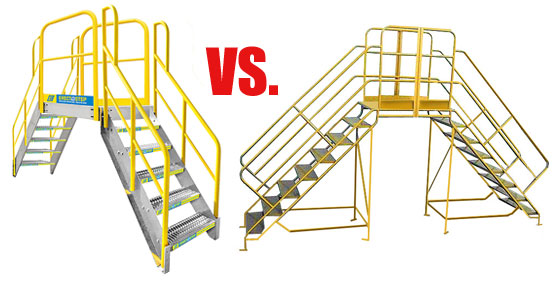Comparison: Modular vs. Tubular Steel Crossovers
There are many options when it comes to crossing over a conveyor line, pipe run or other obstacle

In many operations, things like conveyors or pipe runs or other machinery interrupt the flow of a work floor, and the obvious way to get around it is to erect a crossover. This is commonly done in larger scale conveyor systems with longer lines, but we also do them for other areas where going around the obstacle could take significant time, or where access is limited by other factors. The question is, what type of crossover best fits your needs?
In the past, many if not all crossovers were custom fabricated. A lot of people built their own, and some of those home-made jobs were not exactly engineered for safety. They were also scrap metal if something changed in the operation and their current configuration was unsuitable.
That’s not the case these days – there are relatively economical pre-built crossovers that can fit just about any need, and that meet local building code and/or OSHA safety guidelines. Your access choices now are more diverse than ever. What we’ve run into lately is the option for a permanent crossover, built for the task, and mostly designed to stay in one spot compared to the modular crossover, a flexible crossover system built from common components, but that can be made to fit virtually any space or application.
The Factors
 Equipment Cost: Little doubt of it, the tubular type crossover is less expensive. In a comparison of a simple, two stair system of comparable size, a tubular crossover is clearly less expensive. This model is currently $1,700 or more. If you chose a modular system, the cost is much higher – nearly four times the cost.
Equipment Cost: Little doubt of it, the tubular type crossover is less expensive. In a comparison of a simple, two stair system of comparable size, a tubular crossover is clearly less expensive. This model is currently $1,700 or more. If you chose a modular system, the cost is much higher – nearly four times the cost.- Shipping: Modular crossovers ship disassembled, at a lower freight class and cost. Its cost is reduced relative to the fixed crossover as it costs significantly less to ship, as the modular units are able to ship knocked down and palletized, but that doesn’t account for enough of the cost difference to make it directly competitive. Since they can be palletized, the chances for product damage in transit is reduced.
- Versatility/Transportability: Because the modular systems are built from standard components, akin to tinker toys, they excel at this. They can be disassembled, moved, and reassembled without special tools or expertise. They can be completely re-used, so that their parts could be utilized in building an entirely different structure for re-tasked use. They can be taken down for maintenance or plant reconfiguration and re-installed with relative ease, so their ongoing cost of ownership may be less than that of a welded or tubular crossover. A welded (home made) crossover might have to be cut apart to be moved. A bolted one might need to be re-assembled and have issues with that. Neither of those types can be re-tasked or re-configured easily.
- Availability: In particular, if nothing that is standard will satisfy your need, modular crossovers are much easier to order and can ship quickly — 3 days, as opposed for 3 weeks or more for standard crossovers. Since modular crossovers are built from standard components, those can essentially be pulled from inventory and shipped. Nothing has to be built or put into production. For custom sized tubular or welded crossovers, the wait can be weeks.
Scott Stone is Cisco-Eagle's Vice President of Marketing with 35 years of experience in material handling, warehousing and industrial operations. His work is published in multiple industry journals an websites on a variety of warehousing topics. He writes about automation, warehousing, safety, manufacturing and other areas of concern for industrial operations and those who operate them.




 Equipment Cost: Little doubt of it, the tubular type crossover is less expensive. In a comparison of a simple, two stair system of comparable size, a tubular crossover is clearly less expensive.
Equipment Cost: Little doubt of it, the tubular type crossover is less expensive. In a comparison of a simple, two stair system of comparable size, a tubular crossover is clearly less expensive. 